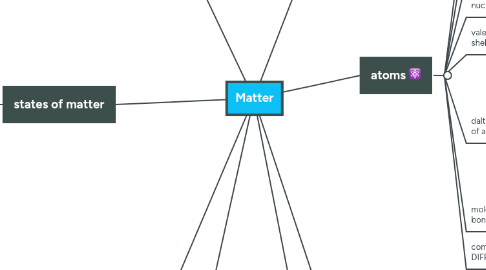
1. periodic table/ elements
1.1. elements = is a single type of atom
1.2. they're 118 elements on the periodic table
1.3. chemical symbol of an element= the letter or abbreviation of the name
1.3.1. made up of one or two letters
1.3.2. first letter is always a capital
1.3.3. if there is a second letters its always lower case
1.4. atomic number= elements are presented in increasing atomic number
1.5. atomic mass= indicates the mass of the element type of atoms compared to other atoms
2. states of matter
2.1. matter is made up of atoms which are held together by bonds that are invisible. the particles behave differently depending on the state of matter.
2.1.1. solid 🧊
2.1.1.1. particles cannot move freely as the bonds are so strong, but they do vibrate.
2.1.1.2. have a specific shape that can be measured
2.1.1.3. the bonds are so strong making it hard to deform the shape of the solid
2.1.2. liquid 💧
2.1.2.1. bonds holding together the particles of a liquid are weaker than a solid
2.1.2.2. take the shape of their container
2.1.2.3. particles in a liquid can move around slowly: on their own within a group, as a subgroup, or as an entire group
2.1.3. gas ♨️
2.1.3.1. bonds between particles are weak
2.1.3.2. particles can move around with much more freedom than in liquids or solids
2.1.3.3. lots of empty space between particles
2.1.3.4. particles can move in all directions allowing gases to expand to fill their entire container
3. particle model/theory
3.1. is used to explain the structure of matter
3.2. main principles of the particle model
3.2.1. 1. all substances are composed of very small particles.
3.2.2. 2. particles within a substance can be similar or different
3.2.3. 3. there is space between particles
3.2.4. 4. particles are constantly moving. the speed of their movement depends on the temperature of the substances
3.2.5. 5. particles either attract or repel each other. the strength depends on the type of particle present
4. chemical change 🔥
4.1. is the transformation (reaction) that DOES change the nature or characteristic properties of matter
4.1.1. the molecules are different before and after the chemical change
4.1.2. chemical changes DO make new substances
4.1.3. most of the time, chemical changes are irreversible
4.2. signs of chemical change
4.2.1. colour change
4.2.2. change in energy (heat or remove heat)
4.2.3. formation of precipitate- a solid substances which forms due to a reaction with an aqueous solution
4.2.4. formation of a gas
4.2.5. ****only ONE is needed for a chemical change, but more than one can occur
5. properties of matter
5.1. non characteristic: a property which various types of matter may have in common
5.2. characteristic: a property which is unique to a specific type of matter
6. atoms ⚛️
6.1. the basic building blocks of all matter
6.2. protons= positively charged, in the nucleus, 1 a.m.u
6.3. neutrons= neutral charge, in the nucleus, 1 a.m.u
6.4. electrons= negative charge, outside the nucleus , 1/1840 a.m.u
6.5. valence electrons= electrons on the outer shell
6.6. daltons atomic model= first representation of atom in 1808
6.6.1. 1. all matter is made up of atoms
6.6.2. 2. all atoms from the same element are identical
6.6.3. 3. atoms of different elements are different
6.6.4. 4. during a chemical reaction, atoms separate, combine or rearrange in a different way to form new substances
6.7. molecule: a group of two or more atoms bonded together
6.8. compound: a group of two or more DIFFERENT atoms bonded together
7. physical change
7.1. is the transformation that does NOT change the nature of characteristic properties of matter.
7.1.1. the molecules are the same before and after physical change
7.1.2. it does not make new substances
7.1.3. most of the time, it is reversible
7.2. phase changes
7.2.1. Solid → gas= sublimation Gas → solid= deposition
7.2.2. Solid → liquid= fusion liquid → solid= solidification
7.2.3. Gas → liquid= condensation liquid → gas= vaporization
7.3. phase change diagram: visual representation of changes in phase when the temperature changes
8. conservation of matter
8.1. started that after a transformation, the quantity of matter stays the SAME.
8.1.1. mass of the matter does not change, because the atoms stay the same

